ActiveOutdoorsOuterwearHow environmentally friendly is fleece?We love a good fleece, but are they good for the planet, and what can you do to lessen their negative impact?When you purchase through links on our site, we may earn an affiliate commission.Here’s how it works.
ActiveOutdoorsOuterwearHow environmentally friendly is fleece?We love a good fleece, but are they good for the planet, and what can you do to lessen their negative impact?When you purchase through links on our site, we may earn an affiliate commission.Here’s how it works.
We love a good fleece, but are they good for the planet, and what can you do to lessen their negative impact?
When you purchase through links on our site, we may earn an affiliate commission.Here’s how it works.
(Image credit: Getty Images)

(Image credit: Getty Images)
When they first burst onto the outdoor scene, thebest fleece jacketsseemed to be the ultimate good news garment. Being synthetic, fleece fabric can keep you extraordinarily warm in really cold conditions, even when it gets wet.
It’s relatively cheap to make and buy, and it’s as tough as old boots – I’ve personally got one that’s over 24 years old, bought just after the Millennium for some wild adventures in New Zealand, and I still use it now.
It’s much more common now to read labels on everything fromcamping tentstotechnical T-shirts,running shoes,backpacksandwaterproof coats, stating that the product has been made of X amount of plastic bottles rescued from the throats of whales in the ocean, or prevented from ending up in landfill – but back in the days of fleece’s infancy, it’s was a complete mind melt. My comfy, warm top is made from old bottles? Are you for real??
So the unpretentious fleece – from the beginning, a garment that saw function being rightly prioritized over form or fashion – was the absolute forerunner in the evolution of environmentally conscious outdoor clothing.
But… (so annoying how these debates always have a big but) modern research has revealed aspects of synthetic fabrics that have caused people to question whether fleece is actually good for the planet at all. Here we dive into the argument – is fleece green or mean?
(Image credit: Getty Images)

(Image credit: Getty Images)
So, what actually is fleece?
Sign up to the T3 newsletter for smarter living straight to your inbox
Get all the latest news, reviews, deals and buying guides on gorgeous tech, home and active products from the T3 experts
In collaboration with Yvon Chouinard’s then-newly launched pioneering outdoor brand Patagonia, the fabric (initially called ‘Synchilla’, positioned as a synthetic version of Chinchilla, a wool-based fabric popular with skiers that arguably represented the true first-generation of performance-orientated ‘fleece’ apparel) was introduced to the outdoor community in 1981.
Very quickly it went absolutely gangbusters, not least because the then CEO of Malden Mills, Aaron Feuerstein, deliberately didn’t patent the material, and so everyone in the industry was able to start making and using it. (Cleverly, while they didn’t patent the invention, Malden Mills did trademark the name ‘Polar Fleece’.)
Soon everyone from weekend walkers, hikers, bikers, kayakers, climbers and campers through to high-end mountaineers and polar explorers had embraced tops made from the material. Fleeces (now the generic name for such garments) are lightweight, affordable, hard-wearing and offer excellent thermal protection from the elements, trapping lots of body-warmed air around your torso.
The magic material is both breathable and hydrophobic – meaning it holds on to very little water (less than 1% of its weight) and, therefore, doesn’t become heavy in rainy conditions. For the same reasons, it can keep you warm when wet, and it dries super quickly, so it’s excellent both as a mid layer and an outer layer.
Single-use plastic items such as bottles are recycled to create fleeces(Image credit: Getty Images)
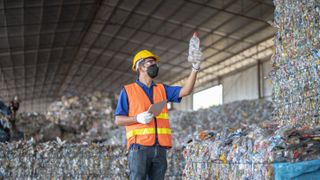
Single-use plastic items such as bottles are recycled to create fleeces
Single-use plastic items such as bottles are recycled to create fleeces
(Image credit: Getty Images)
Polar fleece garments are available in all kinds of thicknesses (the most common being the micro, 100, 200, and 300 variants) and several finishes, ranging from brushed to deep pile. Being entirely synthetic, it’s also suitable for vegans.
Polar fleeces are typically made from recycled polyethylene terephthalate(Image credit: Getty Images)
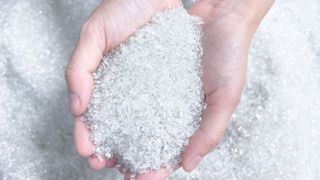
Polar fleeces are typically made from recycled polyethylene terephthalate
Polar fleeces are typically made from recycled polyethylene terephthalate
(Image credit: Getty Images)
That all sounds great – so what’s the problem with fleece?
Like a lot of outdoor apparel, fleeces have often been dyed with problematic substances and treated with potentially harmful chemicals to improve their water repellency. However, with increased awareness of issues around substances such as the evil ‘forever chemicals’ (PCBs, PFCs), big improvements have been made, with recent legislation dramatically cutting down their usage.
The bigger issue around fleeces is the shedding of little bits of the synthetic substance, which primarily happens when you wash them. During the laundry process, tiny microfibres become detached from the garment and end up contributing to plastic pollution in the world’s waterways.
The Microfibre Consortium tests hundreds of synthetic fabrics to assess how much they shed, and the results show that good-quality fleeces made from recycled PET - even brushed and deep-pile style fleeces – do not shed more than other garments(Image credit: Pat KInsella)
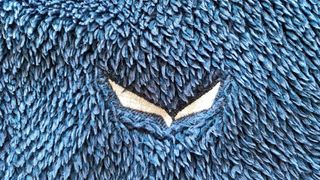
The Microfibre Consortium tests hundreds of synthetic fabrics to assess how much they shed, and the results show that good-quality fleeces made from recycled PET - even brushed and deep-pile style fleeces – do not shed more than other garments
The Microfibre Consortium tests hundreds of synthetic fabrics to assess how much they shed, and the results show that good-quality fleeces made from recycled PET - even brushed and deep-pile style fleeces – do not shed more than other garments
(Image credit: Pat KInsella)
Oh… That sounds bad. Is this really all my fleece’s fault?
Quick answer: no. For some reason, fleeces have become the kicking boy of the clothing industry when it comes to dishing out blame for microfibres entering the world’s waterways and ecosystems. In truth, all clothing made from synthetic materials contributes to this problem, as do a very large percentage of garments made from fabrics that are ‘natural’ (for example, cotton) but are then treated with synthetic substances. In fact, good fleeces made from recycled materials are actually better than most garments.
“I am in favour of synthetic fleeces, but quality ones,” says Charles Ross, a university lecturer and expert in textiles and sustainability. “The shedding rates of a Polartec fleece compared to a cheap fashion one is a tenth of the amount. However, I think all apparel should be made from recycled fibres – no need for more virgin oil to be used – we throw away enough plastic.”
The TMC uses a textile break-off wash-test, and around 800 fabrics have been sampled, producing, Charles tells me, some surprising results. For example, fluffy looking brushed-finish fabrics don’t necessarily shed more than smoothly woven materials during washing – sometimes it’s the other way round.
And, importantly, fleeces made from recycled materials do not release more microfibres than synthetic garments made from non-recycled fabric. “The TMC has data demonstrating that shed rates of rPET are not worse than virgin PET,” confirms Charles.
(Image credit: Getty Images)

(Image credit: Getty Images)
What can we do to stop or minimize the damage?
So, in conclusion, the fact that polar fleeces are made from recycled materials is a very good thing for the planet, and while fleeces do release microfibres during laundering, they don’t shed more than any other synthetic garment.
There are also some measures you can take to make sure you’re not making the microfibre problem worse, including the following.

Build bigger arms in just 30 minutes with this 5-move dumbbell-only workoutIt’ll leave the biceps and triceps popping!
It’ll leave the biceps and triceps popping!
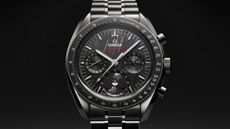
OMEGA puts the moon on your wrist with its new Speedmaster Moonphase MeteoriteOMEGA adds two new Moonphase Meteorite watches to its Speedmaster line-up
OMEGA adds two new Moonphase Meteorite watches to its Speedmaster line-up

Change my mind: the smaller, the better with portable power stationsPut your portable power station to work when you’re not using it
Put your portable power station to work when you’re not using it

Knee pain when hiking? Try these four helpful hacks from a strength coachThere’s no need to hang up your hiking boots just yet
There’s no need to hang up your hiking boots just yet

Feeling cold on your winter hike? An outdoor expert says you’re making this mistakeApparently it’s common with ‘first-time hikers’
Apparently it’s common with ‘first-time hikers’

MSR Hubba Hubba Bikepack 2 review: Lightweight, storm-proof shelter with room to stretchA superb tent, tweaked to make it perfect for pedal-powered adventurers
A superb tent, tweaked to make it perfect for pedal-powered adventurers

5 gadgets you need for your fastpacking adventure, according to an outdoor expertIf you aren’t taking these out for a fastpack, then it’s time too!
If you aren’t taking these out for a fastpack, then it’s time too!

What’s fastpacking: the adventure sport that lets you go further, faster, and lighter on the trailsTrail running meets backpacking for one epic adventure
Trail running meets backpacking for one epic adventure
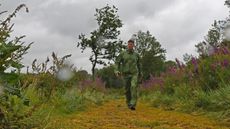
Columbia Wyldwood Waterproof Hiking Shell review: the most waterproof (and shiny) jacket I’ve ever wornIt might not have the matt finish most people expect from a jacket, but the Wyldwood really shines when it comes to protecting you from wet and windy weather
It might not have the matt finish most people expect from a jacket, but the Wyldwood really shines when it comes to protecting you from wet and windy weather
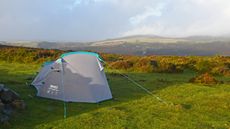
Olpro Stafford 2.0 review: 2-person backpacking tent made from plastic bottlesGood for backpacking couples, this mid-range, 3-season shelter is constructed from recycled trash
Good for backpacking couples, this mid-range, 3-season shelter is constructed from recycled trash